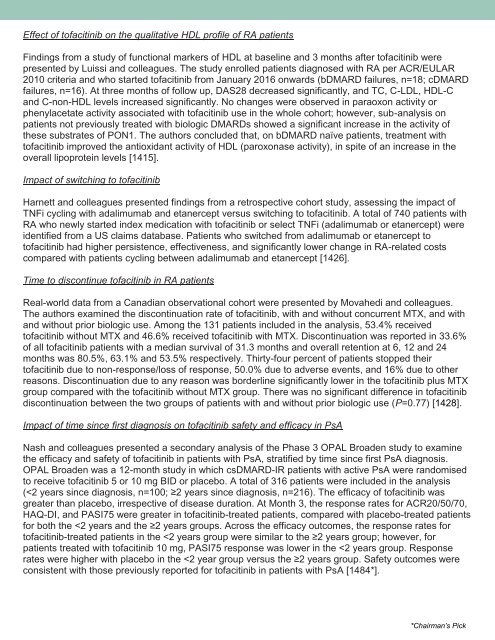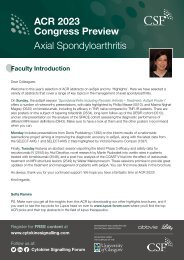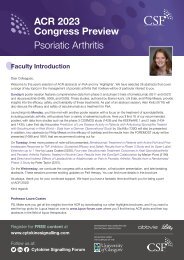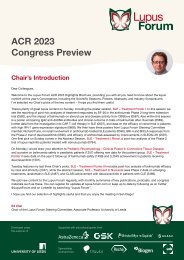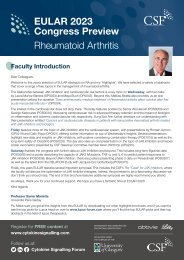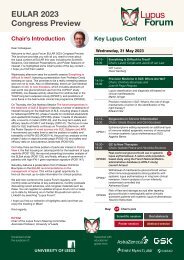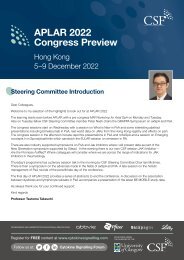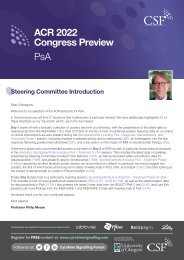ACR Congress Review 2019
You also want an ePaper? Increase the reach of your titles
YUMPU automatically turns print PDFs into web optimized ePapers that Google loves.
Effect of tofacitinib on the qualitative HDL profile of RA patients<br />
Findings from a study of functional markers of HDL at baseline and 3 months after tofacitinib were<br />
presented by Luissi and colleagues. The study enrolled patients diagnosed with RA per <strong>ACR</strong>/EULAR<br />
2010 criteria and who started tofacitinib from January 2016 onwards (bDMARD failures, n=18; cDMARD<br />
failures, n=16). At three months of follow up, DAS28 decreased significantly, and TC, C-LDL, HDL-C<br />
and C-non-HDL levels increased significantly. No changes were observed in paraoxon activity or<br />
phenylacetate activity associated with tofacitinib use in the whole cohort; however, sub-analysis on<br />
patients not previously treated with biologic DMARDs showed a significant increase in the activity of<br />
these substrates of PON1. The authors concluded that, on bDMARD naïve patients, treatment with<br />
tofacitinib improved the antioxidant activity of HDL (paroxonase activity), in spite of an increase in the<br />
overall lipoprotein levels [1415].<br />
Impact of switching to tofacitinib<br />
Harnett and colleagues presented findings from a retrospective cohort study, assessing the impact of<br />
TNFi cycling with adalimumab and etanercept versus switching to tofacitinib. A total of 740 patients with<br />
RA who newly started index medication with tofacitinib or select TNFi (adalimumab or etanercept) were<br />
identified from a US claims database. Patients who switched from adalimumab or etanercept to<br />
tofacitinib had higher persistence, effectiveness, and significantly lower change in RA-related costs<br />
compared with patients cycling between adalimumab and etanercept [1426].<br />
Time to discontinue tofacitinib in RA patients<br />
Real-world data from a Canadian observational cohort were presented by Movahedi and colleagues.<br />
The authors examined the discontinuation rate of tofacitinib, with and without concurrent MTX, and with<br />
and without prior biologic use. Among the 131 patients included in the analysis, 53.4% received<br />
tofacitinib without MTX and 46.6% received tofacitinib with MTX. Discontinuation was reported in 33.6%<br />
of all tofacitinib patients with a median survival of 31.3 months and overall retention at 6, 12 and 24<br />
months was 80.5%, 63.1% and 53.5% respectively. Thirty-four percent of patients stopped their<br />
tofacitinib due to non-response/loss of response, 50.0% due to adverse events, and 16% due to other<br />
reasons. Discontinuation due to any reason was borderline significantly lower in the tofacitinib plus MTX<br />
group compared with the tofacitinib without MTX group. There was no significant difference in tofacitinib<br />
discontinuation between the two groups of patients with and without prior biologic use (P=0.77) [1428].<br />
Impact of time since first diagnosis on tofacitinib safety and efficacy in PsA<br />
Nash and colleagues presented a secondary analysis of the Phase 3 OPAL Broaden study to examine<br />
the efficacy and safety of tofacitinib in patients with PsA, stratified by time since first PsA diagnosis.<br />
OPAL Broaden was a 12-month study in which csDMARD-IR patients with active PsA were randomised<br />
to receive tofacitinib 5 or 10 mg BID or placebo. A total of 316 patients were included in the analysis<br />
(


